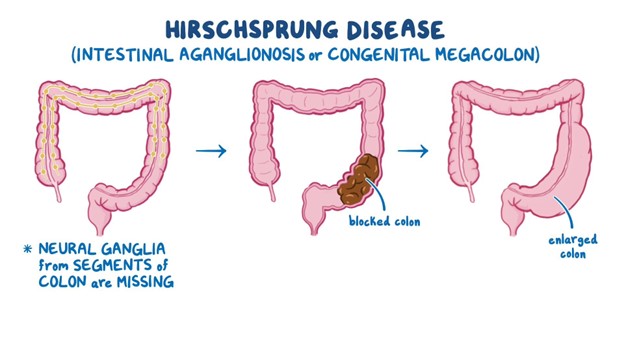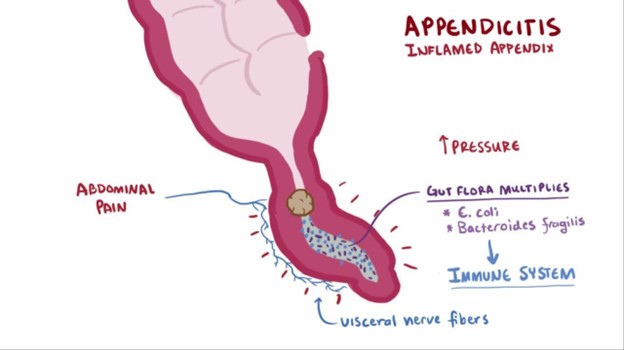A nurse is providing teaching to a parent of a child who has Hirschsprung disease is scheduled for initial surgery. Which of the following statements by the parent indicates an understanding of the teaching?
"I'm glad my child will have normal bowel movements now.
"I want to learn how to use my child's feeding tube as soon as possible
"I'm glad that my child's ostomy is only temporary
I want to learn how to empty my child's urinary catheter bag
The Correct Answer is C
Hirschsprung disease is a condition where nerve cells are missing from parts of the intestine, leading to problems with bowel movements. The treatment for Hirschsprung disease often involves surgery to remove the affected portion of the bowel and create a temporary ostomy (stoma). An ostomy is an opening in the abdominal wall through which waste material can pass into an external pouch, bypassing the affected section of the intestine.
The correct statement by the parent that indicates an understanding of the teaching is C. The parent is expressing relief that the ostomy is temporary, meaning it is not a permanent situation. This response indicates that the parent has been informed about the nature of the ostomy and its planned duration, which is an essential aspect of preoperative teaching.
Let's go through the other options and explain why they are not the best choices:
A. "I'm glad my child will have normal bowel movements now." This statement is not accurate because, after the initial surgery with the creation of a temporary ostomy, the child will not have normal bowel movements. The ostomy is created to bypass the affected part of the intestine, and the child's bowel movements will be directed through the ostomy until further surgery is performed to reconnect the intestine.
B. "I want to learn how to use my child's feeding tube as soon as possible." While learning how to use a feeding tube may be relevant for certain medical conditions, it is not specifically related to Hirschsprung disease or the planned initial surgery. Hirschsprung disease primarily affects the bowel and its function, not the child's ability to eat.
D. "I want to learn how to empty my child's urinary catheter bag." Hirschsprung disease does not directly impact the urinary system, so there is no specific reason for the parent to learn how to empty a urinary catheter bag in the context of this condition or the planned surgery.

Nursing Test Bank
Naxlex Comprehensive Predictor Exams
Related Questions
Correct Answer is B
Explanation
The nurse should clarify the prescription to administer sodium biphosphate/sodium phosphate because it is a laxative and is contraindicated in a child with suspected appendicitis. The use of laxatives or enemas can potentially worsen the condition by increasing the risk of perforation or rupture of the inflamed appendix.
A. Monitoring oral temperature every 4 hours is important to assess for signs of infection or worsening condition.
C. Maintaining NPO status is essential to avoid stimulating the digestive system and to prepare for possible surgery.
D. Medicating the client for pain every 4 hours as needed is appropriate to manage pain and provide comfort while the child awaits further evaluation or treatment.
Remember, it's crucial to avoid the use of laxatives, enemas, or any other interventions that can potentially aggravate the inflamed appendix in a child with suspected appendicitis.

Correct Answer is D
Explanation
D. "My child will take the enzymes to help digest the fat in foods."
Cystic fibrosis (CF) affects the exocrine glands, leading to thick and sticky mucus production, which can block the pancreatic ducts. As a result, children with CF have difficulty digesting fats and absorbing fat-soluble vitamins. Pancreatic enzyme replacement therapy (PERT) is prescribed to help improve fat digestion and nutrient absorption. These enzymes are taken with meals and snacks to aid in the breakdown of fats.
The other options are incorrect:
A. "My child will take the enzymes following meals." - This is the correct timing for taking pancreatic enzymes. The enzymes should be taken with meals and snacks, not following meals.
B. "My child will take the enzymes to improve her metabolism." - The purpose of taking pancreatic enzymes is not related to improving metabolism but to assist in fat digestion and nutrient absorption.
C. "My child will take the enzymes 2 hours before meals." - Taking pancreatic enzymes 2 hours before meals is not the recommended timing. They should be taken with meals and snacks to aid in fat digestion while eating.
Whether you are a student looking to ace your exams or a practicing nurse seeking to enhance your expertise , our nursing education contents will empower you with the confidence and competence to make a difference in the lives of patients and become a respected leader in the healthcare field.
Visit Naxlex, invest in your future and unlock endless possibilities with our unparalleled nursing education contents today
Report Wrong Answer on the Current Question
Do you disagree with the answer? If yes, what is your expected answer? Explain.
Kindly be descriptive with the issue you are facing.
